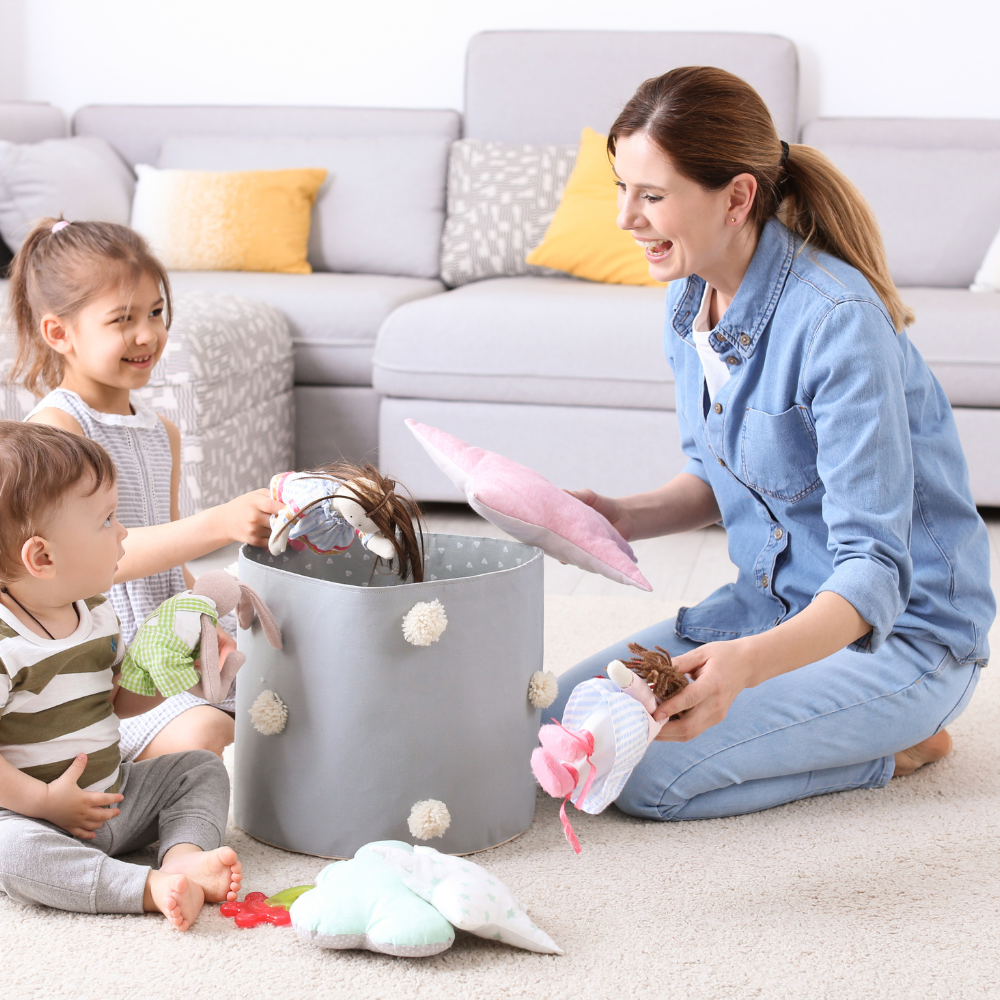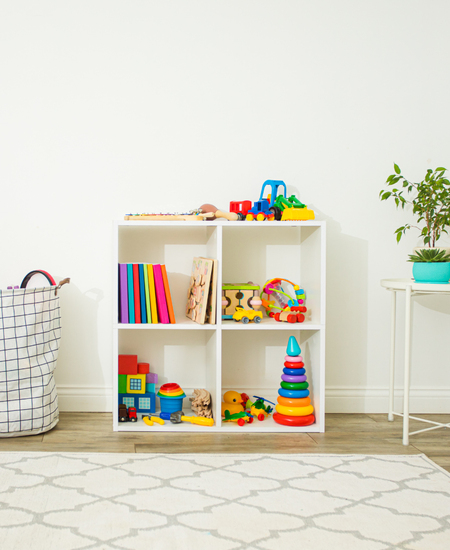As a parent, one of the biggest challenges is keeping your child's toys organized. With kids constantly playing and making a mess, it can be overwhelming to keep their toys in order.
However, having an organized play area not only makes it easier for your child to find and access their toys but also helps in promoting creativity and imagination.
In this guide, we will discuss some useful tips on how to organize children's toys effectively. These tips are easy to implement and will help you maintain a clutter-free playroom or bedroom for your little ones. Let's get started!
Why Its Important to Organize Children's Toys

Children thrive in an organized and clutter-free environment. Having a designated space for their toys not only helps in reducing chaos and confusion but also promotes independence and responsibility in children. When toys are easily accessible and put away in their designated spots, children are more likely to engage in imaginative play and take care of their belongings.
Moreover, organizing children's toys can also save time and energy for parents. Instead of constantly searching for a specific toy or stepping on random pieces scattered around the house, a well-organized toy area makes it easy to find what your child wants to play with. This also promotes a sense of calmness and reduces stress for both parents and children.
Aside from practical reasons, organizing toys can also have a positive impact on your child's cognitive development. Sorting and categorizing toys according to size, color, shape or type can help improve their problem-solving skills and develop their understanding of basic concepts.
Practical Tips for Organizing Children's Toys

There are several strategies and techniques that parents can use to keep their child's toys organized. The key is to find a system that works for both you and your child. Here are some practical tips to help you get started:
Declutter regularly
Regularly decluttering toys is essential for maintaining an organized play area. Set aside time every few months to assess what toys your child actively uses and enjoys versus those that are seldom played with.
Involving your child in this process can also be beneficial, as it teaches them decision-making skills and the importance of letting go of items they no longer need. Consider creating a designated spot for toys that are broken or missing pieces, as these should be removed immediately.
Additionally, donate or recycle toys that are still in good condition but no longer spark joy for your child. This practice not only clears up space but also fosters a mindful approach to possessions, encouraging children to appreciate what they have and share with others.
Use storage bins or baskets
Storage bins or baskets are a versatile and practical solution for organizing toys. They can be used to store different types of toys, such as stuffed animals, building blocks, or dress-up clothes. Choose bins with lids or labels to keep smaller pieces contained and easily identifiable.
For younger children, consider using transparent bins so they can see what's inside without having to open them. This also helps with developing their spatial awareness and memory skills.
You can also use storage boxes specifically designed for toys, which often come in fun designs that add a playful touch to the room. Make sure these boxes have rounded edges and sturdy construction for safety reasons.
Utilize vertical space with shelves or hanging organizers
Another great way to maximize space and keep toys organized is by utilizing vertical space. Install shelves on walls or use hanging organizers from the ceiling to store toys that are not used as frequently.
Shelves can also be used to display your child's favorite toys or books, adding a decorative element to the room. Hanging organizers, on the other hand, are ideal for storing small items like arts and crafts supplies or puzzles.
Make sure to secure all shelves and hanging organizers properly to avoid accidents.
Label toy bins and containers
Labeling toy bins and containers helps both parents and children easily identify where each type of toy belongs. This also encourages children to clean up after playing and promotes responsibility.
You can use pictures or words on the labels, depending on your child's age and reading abilities. Consider using bright colors and fun fonts to make the labels more appealing to children.
Rotate toys to keep things fresh and interesting
Instead of keeping all toys out at once, consider rotating them periodically. This not only keeps the play area less cluttered but also makes old toys feel new again when they are brought back out.
Rotate toys every few weeks or months, depending on your child's interest level and the number of toys they have. This also allows you to store off-season toys, such as outdoor equipment during the winter months.
Teach children to clean up after playing
Teaching children to clean up after playing is an important part of keeping their toys organized. Set clear expectations and create a routine for cleaning up, such as before dinner or bedtime.
Make it fun by turning it into a game or setting a timer for them to race against. Praise and reward your child for following through on cleaning up after themselves.
Involve your child in the organizing process
Involving your child in the organizing process not only teaches them valuable skills but also gives them ownership over their play area. Let them help choose storage solutions and assist with decluttering.
You can also have them help with labeling and rotating toys, making it a fun and collaborative activity. Plus, involving your child in the process will make them more likely to maintain the organization and take pride in their space.
By following these tips and adapting them to fit your child's specific needs and interests, you can create an organized space that promotes learning, creativity, and calmness. Remember to regularly reassess the organization system as your child grows and their toy preferences change.
Why Age-Appropriate Toys Are Important
Choosing age-appropriate toys is crucial not only for your child's development but also for keeping their play area organized. Toys that are too advanced or too simple for a child's age can result in frustration and disinterest, leading to clutter as they look for more stimulating activities. Here are some reasons why age-appropriate toys are important:
- Safety: Toys that are too advanced for a child's age may pose safety hazards as they may have smaller or more complex parts. Plus, toys for older children may contain small pieces that can be a choking hazard for younger kids.
- Developmental Stimulation: Toys that are designed for a specific age range are tailored to stimulate the appropriate skills and abilities. For example, toys with bright colors and sounds are ideal for infants as they stimulate their senses, while puzzles and building blocks promote problem-solving and fine motor skills in older children.
- Longevity: Age-appropriate toys tend to grow with your child, providing them with new challenges as they develop new skills. This means you won't have to constantly replace toys or deal with clutter from outgrown ones.
- Organization: When children have age-appropriate toys, it's easier for them to understand where each toy belongs and how to clean up after playing. This promotes responsibility and helps keep the play area organized.
Choosing toys that are suitable for your child's age is not only beneficial for their development but also for maintaining an organized and clutter-free play area.
How To Choose Age-Appropriate Toys

Choosing age-appropriate toys can feel overwhelming, especially with the vast selection of options available. Here are some tips for every month and year that can help you select the best toys for your child:
0-3 months
When selecting toys for infants aged 0-3 months, focus on sensory stimulation and safety. Soft, textured toys, like plush rattles or cloth books, can engage a baby's sense of touch while being easy to grasp.
Look for brightly colored items that attract their visual attention. Toys with simple sounds, like soft rattles or crinkle toys, can also help develop auditory skills.
Ensure that all toys are free from small parts and made from non-toxic materials to eliminate choking hazards. Mirrors can be fascinating for babies, allowing them to explore their own reflections.
3-6 months
At this stage, babies are starting to develop their gross and fine motor skills. Toys that encourage reaching, grasping, and hand-eye coordination, such as soft blocks or stacking rings, are ideal.
Teething toys can also be great for soothing sore gums and providing oral stimulation. As babies become more mobile, consider introducing toys that move on their own or make sounds when pushed or pulled.
6-12 months
As your baby grows into an active crawler and explorer, choose toys that encourage movement and exploration.
Push toys or ride-on toys can help develop gross motor skills while playsets with manipulative elements like buttons or switches can enhance fine motor skills.
Toys that promote imaginative play, such as dolls or action figures, can also be introduced at this stage. Be mindful of small parts and choking hazards.
1-2 years
Toddlers are full of energy and curiosity, so choose toys that will keep them engaged and stimulated. Simple puzzles with large pieces are perfect for developing problem-solving skills while playsets with multiple functions can encourage imaginative play.
Art supplies like washable crayons and finger paints can help develop creativity and sensory exploration. Outdoor toys like balls, scooters, or sandboxes promote physical activity and outdoor play. As always, safety should be a top priority when choosing toys for this age group.
By selecting age-appropriate toys, you can not only promote your child's development but also help keep their play area organized and clutter-free. Remember to regularly reassess and rotate toys as your child grows and their interests change.
Mistakes To Avoid When Organize Children's Toys

Organizing your child's toys can be a challenging task, but there are some mistakes you should avoid to make the process more efficient and effective:
- Not involving your child: As mentioned before, involving your child in the organization process helps them take ownership of their play area. Don't organize their toys without their input or assistance.
- Overcomplicating storage solutions: Keep it simple when it comes to storing toys. Complex systems may discourage children from cleaning up after playing and can lead to clutter.
- Not decluttering regularly: It's important to reassess and declutter toys regularly as your child grows and outgrows certain toys. This helps keep the play area organized and ensures that your child has age-appropriate toys.
- Not involving your child in the decluttering process: Just like with organizing, it's essential to involve your child in the decluttering process. It teaches them about decision-making and responsibility for their belongings.
By avoiding these mistakes, you can create a functional and organized play area for your child while also promoting their development through age-appropriate toys.
FAQs
What are the best toy storage ideas for organizing kids' toys?
The best toy storage ideas include using bins, baskets, and shelves to keep kids' toys organized. A toy closet with labeled bins for different types of toys, such as tiny toys and baby toys, can help reduce toy clutter. Incorporating a toy rotation system can also keep the play area tidy by only having some of the toys accessible at one time.
How can I effectively manage toy clutter in a small space?
To manage toy clutter in a small space, use vertical storage solutions like wall-mounted shelves and stackable bins. Utilize under-bed storage for random toys and craft supplies, and consider rotating toys to keep the area organized. This approach helps ensure that all the toys have a designated spot, making toy organization more efficient.
What is a toy rotation system, and how can it help organize toys?
A toy rotation system involves cycling through different sets of toys over time, keeping only a few out for play while the rest are stored away. This method helps reduce toy clutter and keeps kids engaged with their toys. By regularly rotating toys, you can maintain a more organized space and make it easier to manage all the toys.
How can I organize tiny toys and small toys to avoid losing them?
Organizing tiny toys and small toys can be done using clear, labeled containers or drawers. Store these in a designated section of the toy closet or on a specific shelf to keep them separate from larger items. This prevents them from getting mixed up with random toys and makes it easier to find and put them away.
What are some tips for organizing baby toys?
When organizing baby toys, consider using soft bins or baskets that are easily accessible and safe for little ones. Place these bins in the toy closet or within reach on low shelves. Regularly declutter and donate toys that your child has outgrown to keep the collection manageable and reduce toy clutter.
How can I organize kids' toys if I have a lot of craft supplies as well?
To organize kids' toys alongside craft supplies, designate separate storage areas for each category. Use labeled bins or drawers for craft supplies and keep them in a different section of the toy closet. Utilize toy storage ideas like rolling carts or divided containers to keep small toys and craft materials organized and easily accessible.
Conclusion
Selecting and organizing age-appropriate toys is crucial for your child's development and play experience. By choosing toys that are suitable for their age, you can promote skills and abilities while also maintaining an organized and clutter-free play area.
Remember to involve your child in the process, regularly reassess and declutter, and avoid common mistakes to create a functional and enjoyable play space for your child. With these tips, you can ensure that your child's toy selection is not only fun but also beneficial for their growth and development.
So next time you're shopping for toys or organizing the playroom, keep these points in mind to make the most out of your child's playtime! So go ahead and let your child have fun with their age-appropriate toys while also promoting responsibility and organization.
Subscribe to our email newsletter and unlock access to members-only content and exclusive updates.

Comments